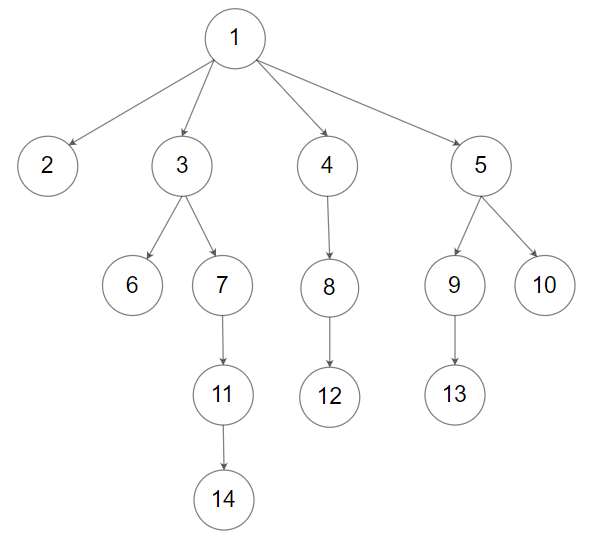原文链接: https://leetcode-cn.com/problems/n-ary-tree-postorder-traversal
英文原文
Given the root of an n-ary tree, return the postorder traversal of its nodes' values.
Nary-Tree input serialization is represented in their level order traversal. Each group of children is separated by the null value (See examples)
Example 1:

Input: root = [1,null,3,2,4,null,5,6] Output: [5,6,3,2,4,1]
Example 2:

Input: root = [1,null,2,3,4,5,null,null,6,7,null,8,null,9,10,null,null,11,null,12,null,13,null,null,14] Output: [2,6,14,11,7,3,12,8,4,13,9,10,5,1]
Constraints:
- The number of nodes in the tree is in the range
[0, 104]. 0 <= Node.val <= 104- The height of the n-ary tree is less than or equal to
1000.
Follow up: Recursive solution is trivial, could you do it iteratively?
中文题目
给定一个 N 叉树,返回其节点值的 后序遍历 。
N 叉树 在输入中按层序遍历进行序列化表示,每组子节点由空值 null 分隔(请参见示例)。
进阶:
递归法很简单,你可以使用迭代法完成此题吗?
示例 1:

输入:root = [1,null,3,2,4,null,5,6] 输出:[5,6,3,2,4,1]
示例 2:

输入:root = [1,null,2,3,4,5,null,null,6,7,null,8,null,9,10,null,null,11,null,12,null,13,null,null,14] 输出:[2,6,14,11,7,3,12,8,4,13,9,10,5,1]
提示:
- N 叉树的高度小于或等于
1000 - 节点总数在范围
[0, 10^4]内
通过代码
官方题解
方法:递归
由于递归实现 N 叉树的后序遍历较为简单,因此我们只讲解如何使用迭代的方法得到 N 叉树的后序遍历。
在后序遍历中,我们会先遍历一个节点的所有子节点,再遍历这个节点本身。
例如:当前的节点为 u,它的子节点为 v1, v2, v3 时,那么后序遍历的结果为
[children of v1], v1, [children of v2], v2, [children of v3], v3, u其中 [children of vk] 表示以 vk 为根节点的子树的后序遍历结果(不包括 vk)。
将结果反转,得到
u, v3, [children of v3]', v2, [children of v2]', v1, [children of v1]'其中 [a]' 表示 [a] 的反转。
此时我们发现,结果和前序遍历非常类似,只不过前序遍历中对子节点的遍历顺序是 v1, v2, v3,而这里是 v3, v2, v1。
因此我们可以使用和 N叉树的前序遍历 相同的方法,使用一个栈来得到后序遍历。我们首先把根节点入栈。
算法
当每次我们从栈顶取出一个节点 u 时,就把 u 的所有子节点顺序推入栈中。例如 u 的子节点从左到右为 v1, v2, v3,那么推入栈的顺序应当为 v1, v2, v3,这样就保证了下一个遍历到的节点(即 u 的第一个子节点 v3)出现在栈顶的位置。在遍历结束之后,我们把遍历结果反转,就可以得到后序遍历。
[sol1]class Solution { public List<Integer> postorder(Node root) { LinkedList<Integer> res = new LinkedList<>(); if (root == null) { return res; } Deque<Node> stack = new ArrayDeque<>(); stack.addLast(root); while (!stack.isEmpty()) { Node node = stack.removeLast(); res.addFirst(node.val); for (int i = 0; i < node.children.size(); i++) { stack.addLast(node.children.get(i)); } } return res; } }
[sol1]class Solution(object): def postorder(self, root): """ :type root: Node :rtype: List[int] """ if root is None: return [] stack, output = [root, ], [] while stack: root = stack.pop() if root is not None: output.append(root.val) for c in root.children: stack.append(c) return output[::-1]
复杂度分析
时间复杂度:时间复杂度:$O(M)$,其中 $M$ 是
N叉树中的节点个数。每个节点只会入栈和出栈各一次。空间复杂度:$O(M)$。在最坏的情况下,这棵
N叉树只有2层,所有第2层的节点都是根节点的孩子。将根节点推出栈后,需要将这些节点都放入栈,共有 $M - 1$ 个节点,因此栈的大小为 $O(M)$。
统计信息
| 通过次数 | 提交次数 | AC比率 |
|---|---|---|
| 65702 | 86138 | 76.3% |
提交历史
| 提交时间 | 提交结果 | 执行时间 | 内存消耗 | 语言 |
|---|
相似题目
| 题目 | 难度 |
|---|---|
| 二叉树的后序遍历 | 简单 |
| N 叉树的层序遍历 | 中等 |
| N 叉树的前序遍历 | 简单 |




